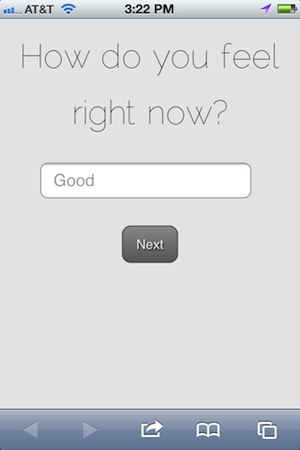
There’s a sarcasm font. It’s brilliant, actually. Reversed italics, slanted left instead of right, perfectly conveys the tone of sarcasm. But sarcasm is practically the default state of online communication. What about the rest of the spectrum of human emotions?
The trouble is that a text-based medium strips our messages of the subtleties we use to interpret each other’s meaning in the real world. The subtexts of our words are audible and visible in person. When we’re talking online, we don’t have those clues. Two people can type the same words and mean completely different things. Hilarity ensues.
We can’t yet rely on machines to compensate for this. Natural language processing is getting pretty good at identifying topics, interests, even demographics, but it’s helpless at interpretation. Semantic algorithms are made of grammar rules, but there are no rules for emotions.
Brennan Novak, an actor and self-taught hacker, has built a Web app called Emoome to try to solve this problem with a different approach. “Language is so nebulous,” Novak says. “Symbols can be interpreted so vastly differently.” So Emoome asks users to feed it words and feelings, and it turns those into emotional maps they can use to understand themselves better. Eventually, Emoome will let us share, compare and understand each other’s emotional profiles.
“Understanding collisions between people” is a lifelong project for Novak, online and offline. He says it’s just his style to navigate emotional conversations with a map in hand. People’s feelings can be rough seas, and Novak has found that good charts can defend against shipwrecks. “It’s a kind of therapy,” he says. “Emotional mapping for communication gives you a more tangible tool than the abstract gray matter of your brain.”
Emoome
emo – a complex psychophysiological experience of an individual’s state of mind as interacting with biochemical (internal) and environmental (external) influences
ome – as used in biology, refers to a totality of some sort
The first step in Emoome’s development is just for tracking the self. You quickly build up a meaningful history just by entering descriptions of your mood a few moments a day. Recording a feeling progresses in three screens. The first asks, “How do you feel right now?”, and you answer with one word. Next it asks, “What is one thing you did today?”, and you can enter a word or phrase. The final screen asks you to describe that one thing in three words.
It only takes a few entries before you have a map of your emotional tendencies, which you can view on the desktop site. Novak arrived at six linguistic categories, which he developed in on-paper experiments testing the basic idea of Emoome with people: physical, action, descriptor, sensory, intellectual and emotional. Each type has a color, and the interface uses size to show the relative importance of the types.
Each user gets an overall language type chart. Here’s mine:
Emoome also shows your dominant types over time. This can reveal shifts around major life events, which is powerful to look back on after the fact. Here’s a segment of Novak’s word type map from his presentation, “The Secret Lives of Words & Brains,” which he annotated to show what happened to him during this period:
The app currently also logs location data for each entry, if you give it permission. You don’t have to enable location for each entry. Emoome doesn’t do anything with location yet, but that’s just one of many ways Novak plans to expand the scope of it.
Eventually, Novak wants Emoome to incorporate relationships. Imagine two people having a text-based online conversation. Emoome can compare the emotional profiles of these two people, because of its emotional graph of the words they use, and give them cues as to the meaning and intent behind their words. Novak has successfully used tangible, external maps as guides for difficult conversations, and Emoome is a project to put that tool online.
But before Novak opens Emoome beyond the individual, he’s building careful privacy rules. “I want it to stay as locked down and private as possible” before adding the comparative aspect, he says. But after determining how to handle these sensitive entries, he can use the data inside them to build useful emotional profiles for people. He wants to be able to connect them to social networks like Twitter and Facebook to add emotional richness to those profiles.
He’d also like to make the data available to researchers. By then, Emoome will hopefully have such rich graphs of emotion that we will be able to build more understanding of emotions right into the software.
Think About How You Think
We have no body language online. We’ve worked around this problem by using emoticons and other novel punctuation, and social networks have given us a few blunt gestures we can use tacitly. Those tricks refine the language of typing, but they don’t cross the Uncanny Valley into the more human-readable, in-person world.
Some apps have started to collect emotional data, but so many of them are framed in a ceaselessly positive light. They ask users to share things they “like” or “love” and award hearts and gold stars to everything. When Novak first started tracking his emotional language, he found that “sad” was his most common word. But, he stresses, that’s not a bad thing. If we’re going to get better at communicating online, we have to start by reflecting honestly on ourselves.
You can check out Emoome at emoo.me and on Twitter @projectemoome.
Bonus material: Check out this old-school RWW story, Feel Good: Top 10 Mood Apps and Visualizers, from July 2007. Some of them still exist, more or less.
Here’s Brennan Novak’s slideshow about the project, The Secret Lives of Words & Brains:
Lead image courtesy of Shutterstock.
Read more : How We’ll Get Beyond the Emoticon



0 Responses
Stay in touch with the conversation, subscribe to the RSS feed for comments on this post.